Recently, I was reminded of a game I had originally seen announced quite a while ago – Ustwo’s indie puzzle game Monument Valley. Available for $3.99 on iOS, Monument Valley has a higher price-point than many mobile games, but the reviews and interview with Ken Wong (designer for Ustwo) I saw made me curious enough to buy it. (MV is only the second game I’ve purchased for iOS, after Continue9876543210?, which I also reviewed here.)
MV’s title – Monument Valley – is shared by a Navajo Nation park in Arizona and Utah with naturally occurring sandstone mesas and buttes. The “monuments” are natural stone formations – but they stand on land that was once inhabited by the Anasazi, a people who no longer exist, whether due to poor land and water management (according to Jared Diamond’s Collapse) and/or the arrival of other hostile peoples. (Or aliens, but that’s another theory that I don’t fully understand.)
The point I’m getting at here is that the name, “Monument Valley,” invokes a natural setting, but it also reminds us of death, of loss, of those who have gone and left behind a puzzle or mystery. It’s also worth mentioning that the Navajo creation myth contains Crow people – as does the game.
It reminds me, also of the Valley of the Kings in Egypt (containing dozens of burials and necropolises) and of the poem “Ozymandias” by Percy Bysshe Shelley:
I met a traveller from an antique land
Who said: “Two vast and trunkless legs of stone
Stand in the desert. Near them on the sand,
Half sunk, a shattered visage lies, whose frown
And wrinkled lip and sneer of cold command
Tell that its sculptor well those passions read
Which yet survive, stamped on these lifeless things,
The hand that mocked them and the heart that fed.
And on the pedestal these words appear:
`My name is Ozymandias, King of Kings:
Look on my works, ye mighty, and despair!’
Nothing beside remains. Round the decay
Of that colossal wreck, boundless and bare,
The lone and level sands stretch far away”.
But those are just impressions I brought with me to the game, rather than things explicitly contained within the game itself. However, the sense of melancholy I get from MV is the same sense I get from “Ozymandias,” the same loneliness and desperation that, I would think, resonates in the abandoned pueblos of the Anasazi and the halls of long-dead pharaohs.
It’s also worth mentioning that the game’s Princess (the protagonist character whom the player guides through the puzzles) is named Ida. This is another poetry reference, this time to “The Princess” by Alfred Lord Tennyson, which was turned into the musical Princess Ida by Gilbert and Sullivan. “The Princess” is about a princess – Ida – who gives up on the world and swears off men (there’s some feminist games commentary right there), but who is wooed in the end by her betrothed, who is willing to don women’s clothing and enter her keep as a woman in order to win her back. That’s not the plot of MV, but it does resonate with the character of the Princess, who appears to have left “the world of men” behind in order to undertake this quest alone.
As always, in any of my analyses there will be spoilers. If you don’t wish to be spoiled, stop reading here. (The short version – I think you should play the game, especially if you liked Braid or Limbo.)
SPOILERS BELOW
The most notable element of MV is its artistic style, which feeds directly into its core gameplay. Each level of MV is a puzzle through which the player must guide the Princess, using components of the level to turn part or all of the structure that makes up that level.
Each level is drawn from or in the artistic style of an M.C. Escher drawing, 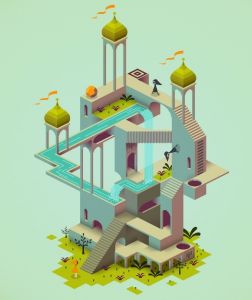
Mechanically speaking, this is one of the coolest parts of playing MV because it requires a perspective shift on the part of the player. The early levels fall within clear physical boundaries, where the illusion is largely optical and doesn’t “break” the laws of physics. Soon enough, however, the player has to relearn how to think about space and physics in order to accommodate this shift in perspective. In essence, as the player, you are required to say But if I look at it from this angle, then things fit together, even though they really don’t.

As I kept playing, I couldn’t help but think the Princess was in some way responsible for the destruction of the civilization of the Crow People, who are now reduced to voiceless wanderers crying out into the night. I felt as though the Princess had to atone for something in the past unknown to me, something she did unwittingly that caused the loss of her people (she is a “Thieving Princess,” after all).
Instead of seeking out or rescuing the Princess, the game requires us to be the Princess rescuing her people, atoning for not being proactive in an earlier time or life. It’s a descent, not unlike that in Continue9876543210?, into a limbo or underworld through which the Princess must travel in order to prove her worth – the quintessential fairy tale quest for the prince, undertaken, instead, by a Princess.

If you turn the princess, make the back of her head (the cone) the front, she becomes an inverted Crow Person. 
In addition to the Crow People and the ghost, there is only one more “character” with which the Princess interacts, and it created one of the most oddly emotional moments in the game came for me. Fairly far into the game, the Princess meets a “friend,” the Totem. The Totem is a tool – the Princess can stand on it, the player can move it, and it helps the Princess traverse several levels before we encounter an ocean. At the end of this level, the Princess rides out into the waves… and the Totem follows her, but, because it is stone, it sinks into the water.
I seriously became upset by this. It was my friend. It wanted to follow me like a giant stone puppy and it drowned because it loved me. It was horrible. (Spoilers again – at a later level the Princess travels down an island, pushing away the waters as she goes, and finds the Totem at the bottom, still “alive.”)
At the end, it turns out that the Princess really is a Crow – the White Crow – and upon completing all the puzzles and quests, she is able to return to her true form. The Crow People also transform, becoming colorful (instead of just black) and growing wings so that they can fly instead of being forced to walk. They transform – but there is a part of me that distrusts the “happy” ending – that sees this final transformation not as rebirth, but as death. After all, we are in monument valley.
Ultimately what is most interesting to me about MV is that even though the game took me under two hours to play, I was still able to produce over 1500 words of analysis… and this just scratches the surface of the thoughts that went through my head while playing. Long story made short, MV is one of the most profound games I’ve played in a long time without being – like Continue9876543210? – inordinately pretentious. MV is a beautiful puzzle game even if you don’t catch any of the allusions to Tennyson or Shelley or even Escher, and definitely worth the time and $3.99. It’s in fact worth far more.
In a time in gaming when gamers are demanding that games provide more content, more replayability, more multiplayer, more DLC, more add-ons and hats and what-have-yous, when the primary discussion surrounding games is about sexism and exploitation and the dominance of the white male hero, Monument Valley brings the opposite. It is simple, refined, has no additional gear or XP, and presents at its core the importance of adopting different perspectives. The game itself requires a paradigm shift, and one that we desperately need.


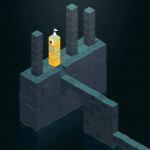
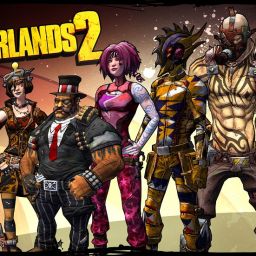
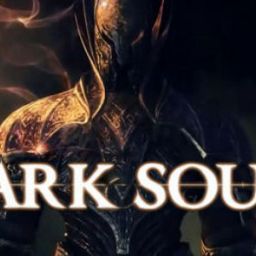
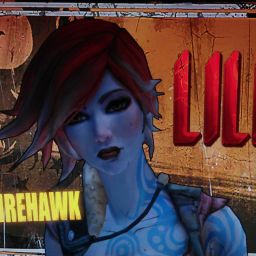

[…] In the midst of all the craziness this year so far, I did manage to play Monument Valley (on a plane coming back from San Diego), and I loved it, so I wrote up a review for TLF. […]
And today it was announced that Monument Valley will get new levels!
http://www.giantbomb.com/videos/the-beautiful-monument-valley-is-getting-new-level/2300-9697/